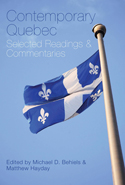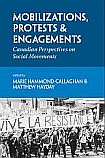Tantramar Candidates' Debate - Detailed Report
On Thursday night, I attended the all-candidates debate for the riding of Tantramar, and then watched the leaders debate on television (the only leaders' debate that I'm going to get to see, it turns out, since cable television in Sackville is provided by Nova Scotia-based Eastlink, rather than Rogers Cable, which is organizing tonight's debate). I posted a few initial comments that evening. Here are some more observations from my notes.
The format was not well suited to detailed discussion of policy or spirited debate. Each candidate was given 5 minutes for their initial presentation. This was followed by three pre-set questions, one for each candidate. The candidate to whom the question was posed was given two minutes to respond, then each opponent was given a minute to rebut, followed by a final minute for the original responder. The floor was then opened to questions for a period of 40 minutes, with each candidate allowed one minute to respond to each question. The last segment was a set of concluding statements of two minutes per candidate.
I'm going to break this down into general policy priorities outlined by each candidate in their statements, including my impressions of each, and then some policy-specific commentary inspired by the questions from the floor.
THE CANDIDATES
Virgil Hammock, NDP
Lest someone accuse me of a pro-NDP bias, I'm starting with Hammock because he drew the first speaking position. His initial statement was somewhat scattered and free-form. His top priority is health care, citing the importance of the Sackville Memorial Hospital as the second-biggest employer in the riding. He is particularly concerned with preserving the local autonomy of the hospital and its capacity to determine which services it can and will provide. His opening statement also stressed improving the seniors' drug plan.
Throughout the night, Hammock stressed his potential role as an independent voice for the riding of Tantramar, and appears to be positioning himself as a swing vote in a deadlocked legislature. His policy positions seem to be personal ones, although generally inspired by NDP positions. His constant refrain was that while the other candidates propose solutions to various problems, it was their past policies that created these problems in the first place.
Mike Olscamp, Progressive Conservative
Olscamp outlined a wide array of priorities in his opening statement. These included 1) Defence of the hospital, its acute care facilities and transportation links to the Moncton hosptial; 2) Seniors - particularly the affordability of nursing homes and the assessment of seniors' incomes for the cost of care; 3) Education - smaller class sizes for elementary and secondary education, the tuition rebate for post-secondary education and continued financial support for Mount Allison; 4) Energy - a tax rebate for fuel heating costs, gasoline price regulation, and gasoline tax reductions; 5) Economic development - low business taxes, road improvements, and a water tower for Sackville.
Olscamp is running on the party's record in office, but also attempting to portray himself as a defender of education priorities, after thirty years of teaching. His closing statement stressed the theme of revitalizing economic opporuntities for young people in a riding and province disadvantaged by geography and resources.
John Higham, Liberal
Higham began his statement with a listing of five key values - Local Accountability, Participation, Fairness, Efficiency and Effectiveness. He might easily have added that he also is in favour of motherhood, puppies and kissing babies - this was a statement which was overly jargon-laden and filled with warm squishy concepts.
He then turned to six key priority areas: 1) Rural Development - developing coastal and fishery resources, rural roads, health networks and education in rural parts of the riding. This priority stressed the theme of bringing families back to the rural parts of the riding. 2) Tourism development - including Cape Jourmain, the Trans-Canada Trail, and possibly a Mi'kmaq village; 3) Knowledge development - improving high-speed wireless access and information technology to replace aging infrastructure; 4) Seniors - a specific cabinet minister responsible for seniors' issues; 5) Education and Health - stressing the need for more local control of these sectors; 6) Energy - removing regulatory barriers.
Higham's closing statement stressed the theme of a need for innovations and experimentation. I got the strong impression that he is trying to position himself as the candidate for rural Tantramar and seniors, as he said little about priorities that would affect Sackville or the university.
THE ISSUES
Economic Development and Infrastructure
One of the most interesting questions from the floor concerned the paving of Walker Road, to make that direct route accessible for trucks heading in and out of Dorchester, and divert them off the provincial highway that runs down Sackville's Main Street. All of the candidates endorsed this - as do I, since the rumble of trucks past our house in the wee hours is a pain.
There were a number of other questions generally about how the candidates would spur development. Hammock stressed the role of entrepreneurship and trying to spin micro-businesses out of Mount Allison. He also stressed local thinking and encouraging people to buy locally in terms of products and food. Olscamp stressed trades teaching, infrastructure improvements and the value of low taxes for attracting businesses such as Moneris. Higham echoed the low tax mantra, and coupled this with improving literacy in the region. Hammock's rejoinder to both candidates was that further lowering taxes would make it difficult to spend on all of their priorities.
Seniors
Seniors' care and seniors' issues were central to both the opening and closing statements of each candidate. Additional questions were asked about reducing the cost of retirement homes and increasing funding for nurse practitioners and nursing home assistants. There was little to differentiate the three candidates on this issue. All were keenly trying to win votes from this constituency. However, each proposed a slightly different approach to reducing seniors' fees for nursing homes. Olscamp spoke of a new formula for the assesment of seniors' assets in judging their ability to pay for care. Higham spoke of a reduction of the daily rate for nursing home care, and an increased number of hours of nurse care per resident. Hammock indicated a desire to incorporate nursing home care into the overall hosptial care and health plan sytem. All supported efforts to increase the number of hours of nurse care per nursing home resident. The room was dominated by senior citizens and near-retirees, and cheers greeted contrete promises, particularly Hammock's proposal to incorporate nursing homes into the health insurance system.
Energy & Environment
With gas and energy prices in the forefront, this was a hot topic for the night. Olscamp spoke of a new water tower and treatment system, more research on climate change and environmental system infrastructure. He also pointed to specific grants made to energy cost relief, and reductions on HST for energy. Higham questioned the logic of reducing the cost of energy as we use more of it and it becomes more scarce. He also spoke of the need to change the regulatory environment in the province. Hammock wants maintain taxes on energy to fix roads and other infrastructure, while blaming the international oil companies for high energy costs.
Over the course of the evening, the theme of wind power generation, which would possibly be based in the Tantramar Marsh, emerged as an idea supported by all three candidates. This has great potential for economic development in Tantramar, and it is a pity it wasn't discussed in more detail.
Education
Higham stressed the need to improve the overall literacy and numeracy rates in New Brunswick, pointing to the McKay report as a model for improvements. He also stressed the need to increase college spaces and distance education, and further integrate schools into communities. Hammock spoke of the high costs of post-secondary education as being a substantial barrier, echoing the call for more community college spaces, smaller class sizes and more teachers. Olscamp spoke of the Lord government's record on reducing K-3 class sizes, and the new investment in additional teachers. I've posted additional detail on the post-secondary education issue here.
FINAL THOUGHTS
No candidate clearly had an overwhelming lead in terms of support from the crowd. The dominant issue of the night was nursing home care and seniors' issues, and both Hammock's proposal for incorporating nursing homes into the health care insurance system and Higham's talk of Liberal promises to increase the number of nurse hours per nursing home resident were warmly greeted by the room. I suspect that the election will likely be won by the candidate who does best with this cohort.
The low number of students in the room might indicate that voter turnout from Mount Allison's students might not be the major factor in this riding that it could be. Certainly none of the candidates were talking directly to the concerns of the Mount Allison community among their major priorities, which may indicate that they don't think the university community is going to be a major factor. The town-and-gown dynamic in this riding is certainly affecting how the candidates craft their messages, and it is being aimed at the town, and indeed, perhaps more towards the rural areas around the town. Recommend this Post






0 Comments:
Post a Comment
<< Home